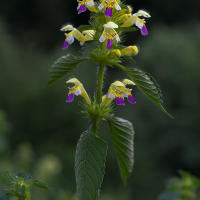Large-flowered hemp-nettle
Galeopsis speciosa
Introduction:
Galeopsis speciosa, commonly known as large-flowered hemp-nettle, is a herbaceous flowering plant belonging to the Lamiaceae family. Native to Europe and parts of Asia, it is known for its distinctive flowers and is found in various habitats, including meadows, woodland edges, and disturbed areas.
Identification:
Appearance: Large-flowered hemp-nettle is an erect, branched plant that can reach heights of 30 to 100 cm. The leaves are opposite, toothed, and often have a rough texture. The most characteristic feature is the large, tubular flowers that range in color from pink to purple, with purple spots and a prominent lower lip.
Distinctive Features:
- Leaves: Opposite, toothed, with a rough texture.
- Flowers: Tubular, large, with colors ranging from pink to purple and purple spots.
- Habit: Erect, branched, reaching heights of 30 to 100 cm.
Habitat and Distribution:
Large-flowered hemp-nettle is adaptable to a range of habitats and is commonly found in meadows, hedgerows, and along woodland edges. It prefers well-drained soils and is distributed across various parts of Europe and Asia.
Cultural Uses:
-
Wildflower Gardens: In certain regions, large-flowered hemp-nettle is appreciated in wildflower gardens for its attractive blooms.
-
Pollinator Attraction: The nectar-rich flowers attract pollinators, such as bees and butterflies, contributing to ecosystem biodiversity.
Management Strategies:
Galeopsis speciosa is generally considered a wildflower and doesn't require specific management in naturalized settings. However, in cultivated gardens, here are some considerations:
-
Cultivation: Large-flowered hemp-nettle can be grown from seeds in well-drained soil with ample sunlight.
-
Pollinator-Friendly Practices: Encourage pollinators in the garden by planting a variety of nectar-rich plants, including large-flowered hemp-nettle.
Caution: While Galeopsis speciosa is not known for toxicity, it's important to exercise caution and proper identification when introducing any plant into a garden or landscape. Additionally, be mindful of its potential to self-seed and spread in certain settings.







